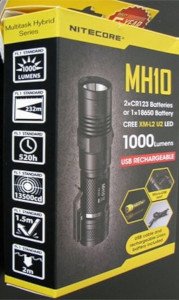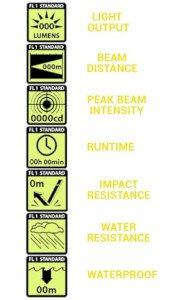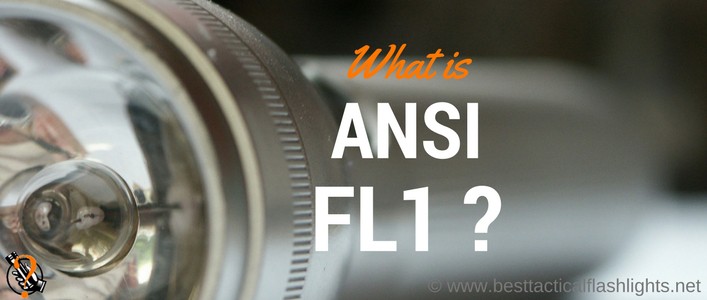Have you ever looked at a flashlight box and wondered what the different icons meant? Have you ever heard the term ANSI FL1?
Have you ever wondered how flashlight standards are set? Are you new to the world of flashlights? ANSI FL1 are standards used by many flashlight manufacturers to enable you to compare different flashlights.
If you are looking for lights with the most output you need to make sure the flashlight has been tested to some standard like ANSI FL1.
Keep on reading to find out everything you need to know about ANSI FL1 standards.
What is ANSI FL1?
Before ANSI FL1 standards were created there was no way to compare different flashlight features. In order to compare flashlight features there needed to be some kind of standardized test manufacturers could use to compare features. Without the standards put in place, consumers had no way of determining what light was better based on the manufacturer’s claims.
Manufacturers were also frustrated as they had no way of backing up their claims. Even if manufacturers created high-quality flashlights they had no way of proving their version was better than their competitors. We have a guide that keeps track of the top output lights by battery. Check out the crazy amount of lumens we are up to now.
To make it easier for both consumers and manufacturer’s the National Electrical Manufacturers Association (NEMA) put together the Flashlight Standards Committee. Members of this committee came from NEMA, ANSI, and 14 portable lighting companies, including Surefire, Streamlight, Duracell, and several others. On August 18, 2009, the standards known as ANSI/NEMA FL-1 were approved by the American National Standards Institute (ANSI). These standards allow consumers to compare the claims made by manufacturers to ensure they choose the light that bests meets their needs.
How Manufacturers Use ANSI FL-1

By creating the ANSI FL1 standards ambiguous marketing terms would no longer be used by manufacturers when describing their flashlights. Although most flashlight manufacturers follow the ANSI FL1 standards using them is strictly voluntary. Currently, there are 10 manufacturers who use ANSI FL1 standards on their packing. These companies are 4Sevens, Brinkmann, Energizer, NEXTORCH, Fenix, JETBeam, Inova, Mag Instrument, Streamlight, and Shumway.
If a manufacturer decides to adopt the ANSI FL1 standards on their package they have the ability to pick what they want to display. Manufacturers are not required to display all of the ANSI FL1 standards on their packaging. Manufacturers can pick and choose different standards for different lights. Even though manufacturers have the ability to choose what is displayed they still need to follow strict guidelines when it comes to conducting the tests. The ANSI FL1 standards testing can be done by the manufacturer or through a third party.
If a flashlight manufacturer chooses to display the ANSI FL1 standard icon they are stating that the lights performance complies with all ANSI FL1 standards. Even if only one claim is made all of the rest of the manufacturer’s claims must adhere to the ANSI FL1 standards.
What ANSI FL1 Standards Mean for Consumers
As a consumer ANSI FL1 standard makes it easier for you to compare flashlights from different manufacturers. The ANSI FL1 standards allow users to rate and compare different features. With ANSI FL1 standards consumers no longer have to worry about the wide variety of phrases used to describe the same features on different lights. An ANSI FL1 standard gives a strict definition to each feature. Being able to compare the same features on different lights helps consumers choose the best light for their needs.
What Are The ANSI FL1 Standards Icons Used?
If you have ever compared flashlights you have probably noticed several different icons being used to describe different features of the light. These are known as the ANSI FL1 Standards icons. These icons signal to a consumer and other manufacturers that the product has been tested by the manufacturer or an independent lab. In order to compare the features, it is important for you, the consumer, to know what each icon means.
Light Output
The amount of light emitted from the flashlight is measured in lumens.
Many people confuse wattage with lumens. Lumens as we said measures the light output. Wattage is the amount of power used by the light. Lumens are used as a comparison method because it is the only way to get an accurate measurement of how much light the flashlight can emit.
LEDs have improved the efficiency of today’s flashlights. These improvements allow flashlights to consume less power while emitting a brighter light.
Beam Distance

This standard looks at light projection. Beam distance can best be described as how far the light can project useful light.
Measured at 0.25 lux beam distance is commonly displayed in meters. 0.25 lux is the equivalent to the amount of light emitted from a full moon on a clear night.
We have a guide that keeps track of the top beam distance lights by battery, some lights can throw way over a kilometer.
Run Time
This test is always conducted using fresh batteries. All lights are tested with the batteries that come with the light. If the light doesn’t have batteries the test is done using the batteries recommended by the manufacturer. Expressed in minutes, run time is how long the light will continuously run before output drops to 10% of its original value. The first measurement, which is its original value, is taken 30 seconds after the light is turned on. Output is then measured every 15 minutes until the light drops to 10% of its original value.
Peak Beam Intensity
Peak beam intensity is the brightest point of the flashlight’s beam. Beam intensity is measured in candelas.
To measure peak beam intensity the light must be on its highest setting with the tightest focus. A lux reading is taken from the brightest portion of the beam at 2m, 10m, or 30m away from the light. The lux reading must be taken within 30 to 120 seconds of the light being powered on.
To get the candela the lux reading is multiplied by the square of the distance, so no matter what distance the candela value will remain the same.
We have an article that goes a little more into candela and what people confuse it with Candlepower. We also go over how to convert from candela to lumens if it is possible.
Impact Resistance
Impact resistance is how far the light can be dropped onto concrete and still work properly. Lights are dropped in the off position, batteries and all intended accessories must be installed during testing. With the impact resistance is measured in meters. The first test requires the light to be dropped from one meter onto cured concrete in the off position. The light is then inspected for any cracks or breaks. The light is also tested to ensure it still functions properly. If the light survives the 1-meter impact it is then tested further. The further tests require the light to be dropped six different times. Each drop requires a different face towards the ground. The light is inspected after each impact for any kind of damage. Once damage occurs the meters are noted.
Water Resistance/Water Proof
This is commonly referred to as a flashlight’s IPX rating. Currently, there are three IPX ratings for flashlights. An IPX4 rating means the light can handle water being splashed from all directions. An IPX7 rating allows the light to be fully submersed in one meter of water for up to 30 minutes. An IPX8 rating allows a light to be fully submerged at a specified depth for up to four hours. To pass the test the light must properly work immediately after the test and 30 minutes after. Testing for IPX7 and IPX8 ratings must be performed after impact resistance testing to ensure the light is watertight in real life conditions. If you need to know more about this check out our post on IP Ratings.
Interpreting the ANSI FL1 Standards
Now that you know what the standards are and how they are used you need to understand what they mean. Some of the standards are pretty straight forward, such as runtime, impact resistance, and water resistance. Where things get a little tricky is with peak beam intensity, light output, and beam distance.
Many consumers assume that the higher the lumens the brighter the light is going to be, but that is not always the case. Light output is the amount of light that comes out of the front of the light. Light output is directly related to how much power a light uses and how efficient the LED is. The peak beam intensity is how bright the light appears as perceived by your eye. It is directly related to how the beam is focused through a reflector, lens, or another optic. Light output is important, but how that light is dispersed is what determines usefulness.
Spot and Flood Beams

With flashlights, you have the choice between spot and flood beams.
Most manufacturers will tell you what kind of beam the light features, but you can figure it out on your own. To determine the type of beam you need to look at the candela per lumen ratio.
Spot beams have a large candela/lumen ratio and are ideal for lighting up distant objects. Flood beams have a small candela/lumen ratio and are preferred for close up work. Tactical lights have a 20-100 candela/lumen ratio allowing then to be used for a wider range of applications.
Perceived Brightness
This is something that is really hard to measure numerically because of the way our minds work. In looking at the numbers one would assume that a light with a peak beam intensity of 10,000 candelas is twice as bright as a light with a beam intensity of 5,000 candelas. This is not the case. When comparing peak beam intensity in order for the light to be twice as bright to the human eye it has to be four times as intense.
ANSI FL1 Limitations
The ANSI FL1 standards are certainly helpful for those who are looking to compare flashlights, but it does have limitations. Understanding those limitations will allow you to use the ANSI FL1 standards to their fullest potential when picking out your next light.
Run Time
With ANSI FL1 standards run time is the biggest limitation. The reason for this not all flashlights or batteries work the same way. Batteries lose voltage as they discharge, so a 1.5v battery doesn’t always emit 1.5v. Different batteries will also elicit different runtimes, which is not always disclosed by manufacturers. Run times are best expressed by a graph, but currently, ANSI FL1 standards do not require it. Run time alone should never be a deciding factor in choosing a light as it can greatly vary based on other factors.
Impact Resistance
This standard is something to keep in the back of your mind, but should not be a deciding factor. The electronic circuits that regulate the LED are not as durable as the body of the light. Most lights can handle occasional drops, but dropping the light repeatedly can lead to operational issues or even total operation failure. Avoid dropping or damaging the light as much as possible.
ANSI FL1 Final Thoughts
When looking for a new flashlight the first thing you want to do is compare similar lights. You want to be able to see what each light has to offer so you can choose the one that is right for you. ANSI FL1 standards were created and adopted in 2009 to provide consumers with an easy way to compare flashlight features. Now that you know what the ANSI FL1 standards are you can use them to pick your next light. Thank you for visiting BestTacticalFlashlights.net. Please take a look at our flashlight reviews or our flashlight buyers guides for all your flashlight needs.
